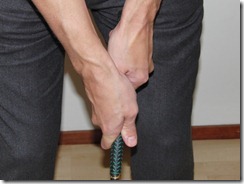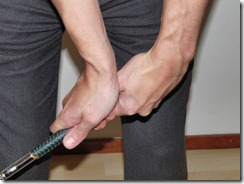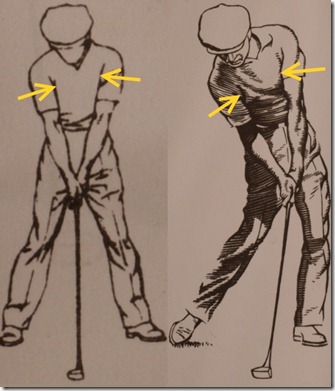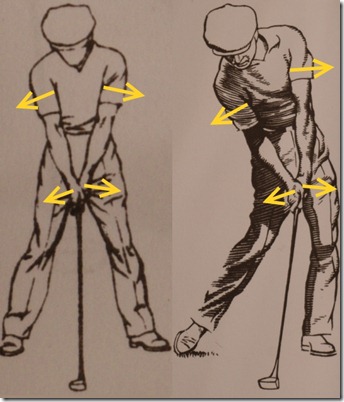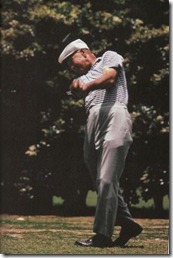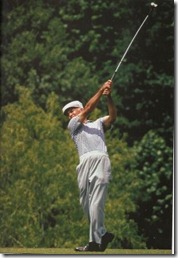Here we see Ben Hogan practicing his chipping. Note the unorthodox technique he uses in this video. When I first saw this I immediately thought that it might be a good way to play short chip shots. I like that there’s very little moving parts, which would help consistency. Also, the fact that the wrists have to do the bulk of the work allows you to go at it a little more aggressively and really trap the ball against the turf.
Technique
On the way back it looks like he uses a combination of bowing and turning of his (left) wrist. Below you can see what I think that he’s doing with his wrists. Note that the forearms may or may not participate, depending on the length of the shot.
Address (left) and end of ‘backswing’ (right).
On the way down simply pull the club through using the pivot while performing the exact opposite of the move you made in the backswing.
There is a document floating around on the internet which supposedly contains transcriptions of letters that Hogan wrote to friends. I seriously doubt that it really is Hogan who wrote those letters. But anyway, since it contains a few paragraphs about this chipping technique I thought I’d share it anyway.
Here it is:
"The Hogan Letters: Written by Ben Hogan 7-20-78
---As to your inquiry about chipping I haven't explained it to you because you've never asked and I thought perhaps you had no problems with them. The best method that I have ever used was explained to me and demonstrated by Bobby Jones many years ago when I was a neophyte golfer. It has proven to be invaluable in salvaging pars from fifty yards into the green, and I have yet to find a better method. With a little practice it will give you accuracy and you can hit it to the pin with assurance that you will have an excellent chance for a one putt and a par.
Snead stole it from me when we were playing together in the Tam O'Shanter in Chicago and the rascal went on to win the tournament. Snead is very observant of other golfers unique or special shots and watched me knock one up to within four feet on the second hole from twenty-yards. The ball floated up hitting about 10-feet and rolled like a putt right at the cup. He didn't say anything but on the sixth hole, a 540 yard par 5, he was about 25 yards from the green and he pitched one up using my technique and almost holed out, but had only a two-foot putt for a birdie. "You see," he said, "us mountain boys learn fast, and are not as dumb as you think." Since then I have revealed it to Trevino and of course Dickinson. It has salvaged a list of pars for them.
The basic idea (and now we get down to brass tacks) is to take a normal square stance (not open or closed) and a good grip (V's of left and right hand pointing midway between chin and right shoulder with the club face square to the line (be sure to not open or close the club face), then take the club back turning the hands clockwise 90-degrees bending the right elbow which folds as the hands move up in a short arc all the while keeping the upper part of the right arm in the same position as it was at address (in other words the upper part of the right arm does not change position in relation to the body). Very little movement of the legs is involved if any (keep knees flexed and limber). Keep your eye on the ball and swing the club head down to the ball. The hands will automatically revert to the position at address and will move the head of the club head (a nice delayed clipping action).
The ball should be struck crisply and a nice divot taken, which will be in line with the flight of the ball. The firmer the ball is hit the higher the arc it will take with less run as it hits. The shorter the hit the more run involved but the ball will settle down and run as a putt. It is simply a matter of practice, but one can be very bold with this technique because it minimized the amount of roll to a far greater extent than chipping with a seven or eight iron. Jan salvaged 5 pars with it and shot ? in the grocery tournament and was eight strokes up on second place. If she keeps it up they will ban her so she has to lose a couple.See you soon sincerely
Ben Hogan”

